Which Statement is True Regarding Policy Dividends
When it comes to insurance policies, one aspect that often confuses policyholders is the concept of policy dividends. As an expert in the field, I can shed some light on this topic and help you understand which statement is true regarding policy dividends. Policy dividends are essentially a return of premium to the policyholder, based on the insurer’s financial performance. However, there are certain factors that determine whether policyholders are eligible to receive dividends, and it’s important to know the truth behind these statements.
Firstly, it’s important to note that not all insurance policies offer dividends. Dividends are typically associated with participating policies, which are commonly found in the life insurance industry. These policies are designed to share the insurer’s profits with policyholders, and dividends are one way of doing so. However, it’s crucial to understand that dividends are not guaranteed and can vary from year to year based on the insurer’s financial results.
What Are Policy Dividends?
Definition of Policy Dividends
Policy dividends are a unique feature offered by some insurance companies. They are a return of premium to policyholders based on the insurer’s financial performance. However, not all insurance policies offer dividends, and the amount received can vary.
Purpose of Policy Dividends
The primary purpose of policy dividends is to provide an additional benefit to policyholders who have purchased participating policies. Participating policies are commonly found in the life insurance industry. These policies are designed to share in the financial success of the insurance company.
When an insurance company performs well financially, it may decide to distribute a portion of its profits to policyholders in the form of dividends. This is a way for the company to reward its policyholders for their loyalty and encourage them to continue their coverage.
Policy dividends can serve multiple purposes for policyholders:
- Enhanced Cash Value: One common use of policy dividends is to increase the cash value of the policy. The cash value is the amount of money that can be accessed or borrowed against during the policyholder’s lifetime. By reinvesting dividends into the policy, the cash value can grow over time, providing additional financial security.
- Premium Reduction: Policyholders may also have the option to use dividends to offset future premium payments. By applying dividends towards premiums, policyholders can reduce the out-of-pocket expense of maintaining their insurance coverage.
- Paid-Up Additions: Another way to utilize policy dividends is to purchase paid-up additions. These are additional insurance coverage units that are fully paid for and do not require any further premium payments. By using dividends to purchase paid-up additions, policyholders can increase the death benefit or cash value of their policy.
It is important to note that the dividend amount is determined by several factors, including the insurer’s financial performance, the policyholder’s premium payments, and the policy’s participation rate. Policyholders should review their policy documents and consult with their insurance provider to understand how dividends are calculated and how they can be utilized.
Policy Dividends vs. Cash Value
Understanding Cash Value
When it comes to life insurance policies, it’s important to understand the concept of cash value. Cash value refers to the accumulated savings component of a permanent life insurance policy. As you make premium payments, a portion of these payments goes towards building the cash value of your policy. Over time, the cash value grows and can be accessed by the policyholder.
Differences between Policy Dividends and Cash Value
While both policy dividends and cash value are associated with participating life insurance policies, they serve different purposes and are calculated differently. Here are the key differences between policy dividends and cash value:
- Origin of Funds: Policy dividends are a return of premium provided by the insurance company based on their financial performance. On the other hand, cash value is the savings component that accumulates within the policy based on the policyholder’s premium payments.
- Calculation: Policy dividends are typically calculated using a formula that takes into account factors such as the insurer’s financial performance, the policyholder’s premium payments, and the policy’s participation rate. Cash value, on the other hand, grows based on a predetermined interest rate set by the insurance company.
- Purpose: Policy dividends can be used in multiple ways, such as enhancing the cash value of the policy, reducing premiums, or increasing coverage. The policyholder has the flexibility to choose how they want to utilize their dividends. On the other hand, cash value serves as a savings component within the policy that can be borrowed against or withdrawn by the policyholder.
- Guarantees: Policy dividends are not guaranteed and can vary based on the insurer’s financial performance. The amount of dividends received can fluctuate from year to year. On the other hand, cash value has a guaranteed minimum growth rate, ensuring that the policyholder’s savings continue to accumulate over time.
- Tax Implications: Policy dividends are generally not taxable if received as a reduction in premiums or used to enhance the cash value of the policy. However, if the dividends exceed the total premiums paid, they may be subject to taxation. Cash value, on the other hand, grows on a tax-deferred basis, meaning that the policyholder does not have to pay taxes on the growth until it is withdrawn.
Policy dividends and cash value are two distinct features of participating life insurance policies. While policy dividends provide a return of premium based on the insurer’s financial performance, cash value represents the accumulated savings within the policy. Understanding the differences between these two features can help policyholders make informed decisions about their life insurance coverage.



